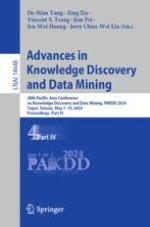2024 | Book
Advances in Knowledge Discovery and Data Mining
28th Pacific-Asia Conference on Knowledge Discovery and Data Mining, PAKDD 2024, Taipei, Taiwan, May 7–10, 2024, Proceedings, Part IV
Editors: De-Nian Yang, Xing Xie, Vincent S. Tseng, Jian Pei, Jen-Wei Huang, Jerry Chun-Wei Lin
Publisher: Springer Nature Singapore
Book Series : Lecture Notes in Computer Science
